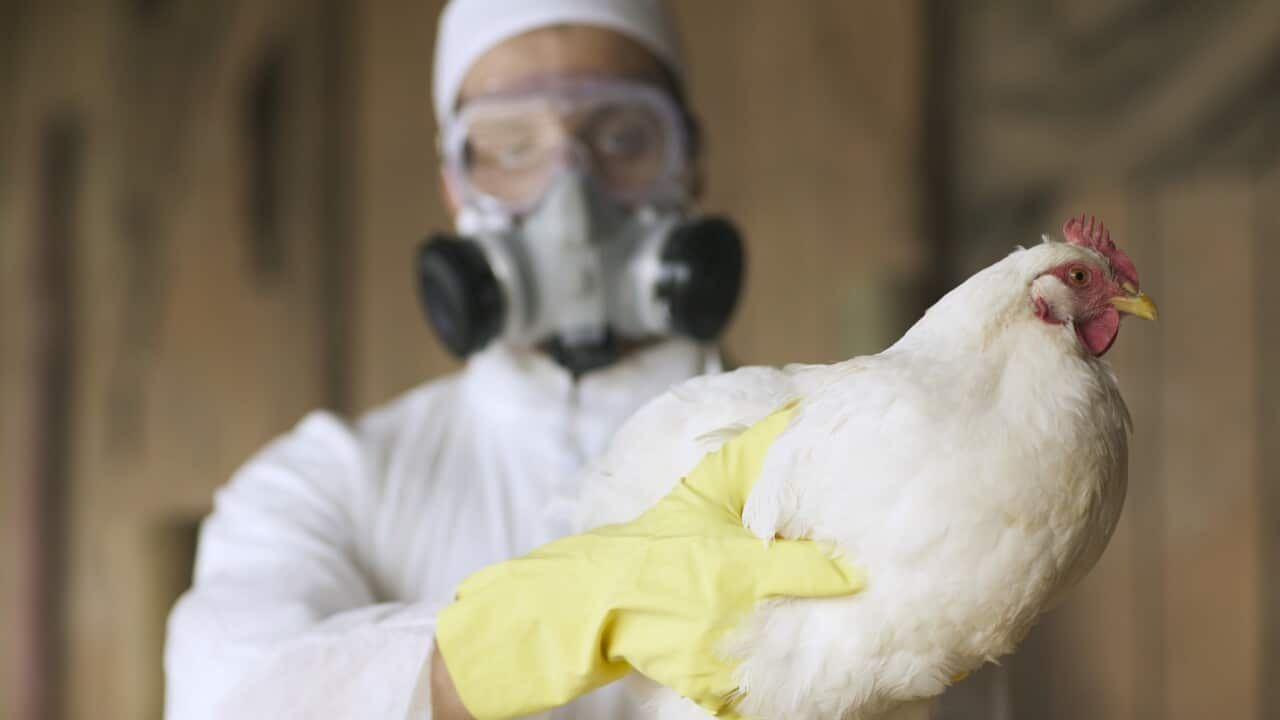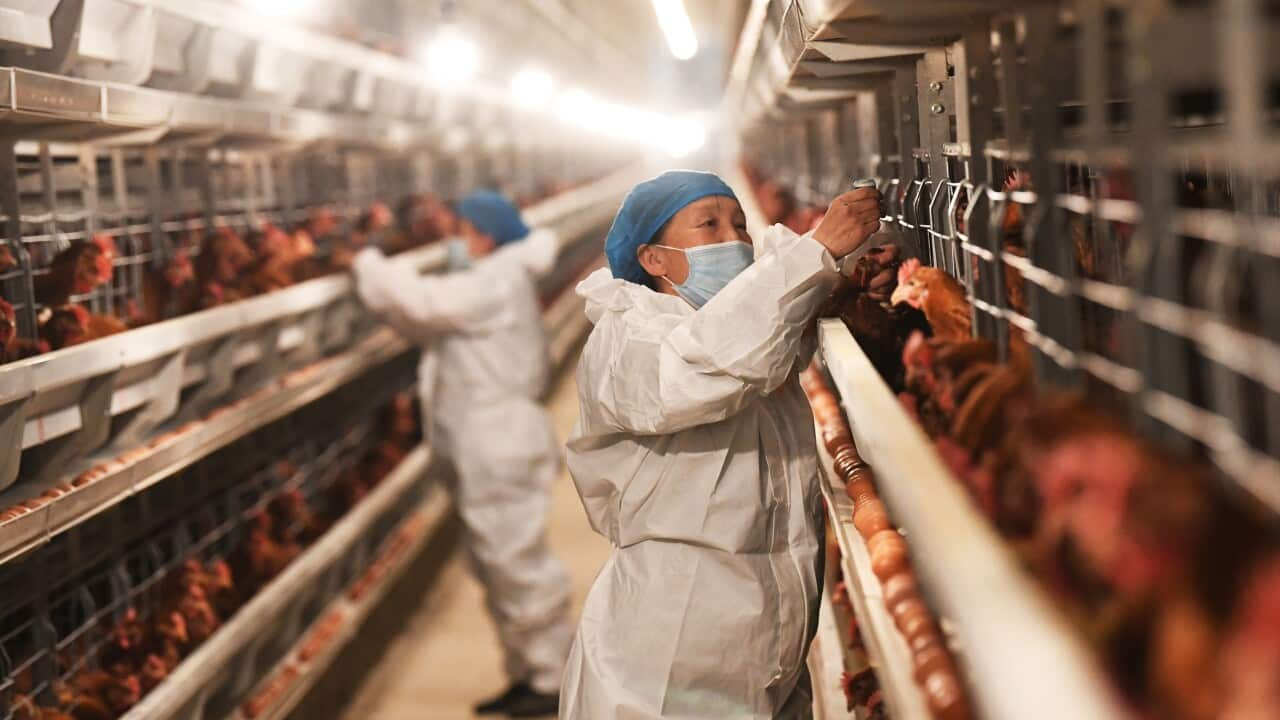Key Points
- The H5N1 strain of bird flu is spreading rapidly to new territories and species.
- It's yet to reach Australia, which is surprising, according to one expert.
- The strain is rarely seen in humans though the mortality rate is high.
The H5N1 bird flu strain is in flight. It's infected more and more animal species, has now passed from a cow to a human, and has been detected in raw cow's milk. It's also reached new territories for the very first time, including South America and Antarctica.
Associate Professor Kirsty Short, a virologist at the University of Queensland, said H5N1 is a particularly worrying strain.
"We're concerned at the rapidity at which H5N1 has spread and the fact that it's spread to places where previously avian flu was not present," she told SBS News.
"It's a major ecological problem."
So which animals are most at risk and how can we protect them? How dangerous is H5N1 for humans? And when is it expected to arrive in Australia?
Which animals has H5N1 impacted?
Avian influenza A (H5N1) first emerged in 1996 but since 2020, the number of outbreaks in birds has grown exponentially, alongside an increase in the number of infected mammals.
The strain has led to the deaths of tens of millions of poultry, with wild birds and land and marine mammals such as seals and sea lions also infected.
Cows and goats joined the list last month – a surprising development for experts because they were not thought to be susceptible to this type of influenza.

The H5N1 bird flu strain has now been found in marine animals, cows and goats. Source: AAP / Charlie Litchfield/AP
"Now we see multiple herds of cows affected in an increasing number of US states, which shows a further step of the virus spillover to mammals."
Short explains that every new species the virus infects is an opportunity for it to adapt.
"The more mammalian species that we see infected, the more likely we are to see mammalian adaptations."
Is H5N1 in Australia and what damage could it do?
H5N1 is not yet here, which is "incredible" given it's carried in wild migrating birds, Short said
"I'm perplexed as to why it's not here at the moment, and I'm hoping that that's a really positive sign, but I don't think we can bank on that. All it takes is a few wayward birds."

The H5N1 strain of bird flu is spreading rapidly, appearing in new territories and new animal species.
"We want to protect our poultry industry, but think about all the unique bird populations we have in Australia, and we know some of them are inherently susceptible to avian flu."
Black swans, which breed mainly in southwest and southeast parts of the country, are one example.
"We did a study a couple of years back showing that black swans are really, really susceptible and it would be devastating if we lost them as a species."
How much are humans at risk from H5N1?
From 2003 to 1 April this year, the WHO said it had recorded 463 deaths from 889 human cases across 23 countries, putting the case fatality rate at 52 per cent.
Though the human cases recorded in Europe and the United States in the past few years – since the virus surged – have been mild cases, Zhang notes.
Infection is passed to humans through handling live infected birds, through contact with bird faeces or through slaughter, de-feathering or butchering infected birds, according to the Department of Agriculture, Fisheries and Forestry.
Earlier this month on a dairy farm in Texas, a cow passed avian flu to a human for the first time, according to the WHO.
It was only the second case of a human testing positive for bird flu in the United States, and came after the virus sickened herds that were apparently exposed to wild birds.
The virus may have found other routes of transition than we previously understood.Wenqing Zhang, head of the global influenza programme at the World Health Organization
So far, there is no evidence that H5N1 is spreading between humans.
Short said the risk to humans at this point is "relatively low but still there".

It's possible that H5N1 could one day be able to transmit efficiently between humans. Source: AAP
"Whether or not that will change in the future, I don't know."
Is there a bird flu vaccine?
Zhang said there are close to 20 influenza vaccines licensed for pandemic use and they could be tailored to work against the specific virus strain in circulation.
There are also antivirals that could be used to treat human infections, with new vaccines also in development.
"We are working on new vaccine strategies that can be rapidly rolled out specifically for this virus," Short explained. "There's a lot of really active research going on about this specific strain so that if something does happen, we are prepared. "
What about H5N1 in milk?
The virus has also been detected in raw milk from infected animals in "very high virus concentrations", Zhang said, but experts were still investigating exactly how long the virus is able to survive in milk.

Bird flu strain H5N1 has been found in raw milk taken from infected animals. Source: Getty / Getty Images
"It is important for people to ensure safe food practices, including consuming only pasteurised milk and milk products," Zhang said.
What can Australians do?
Mitigating the risks is about constant surveillance and vigilance, Short said.
"We're looking at what an outbreak here would that look like, how we would protect our poultry populations, how we would protect our wild bird populations and how we would protect people working in the sector.
"It's about having those preparedness plans worked out now when we have the luxury of time."
Short advised the public, and chicken farmers in particular, to be aware but not alarmed.
"The message to get out to the public is if you do see a dead bird report it, it's probably nothing. But we just need the community to act as part of the surveillance so we know it is coming into the country.
"And if farmers do have sick chickens or experience a drop in egg production, take note of it.
"This virus isn't in Australia at the moment. So there's nothing other than being vigilant that we can really do."
- With Agence France-Presse










